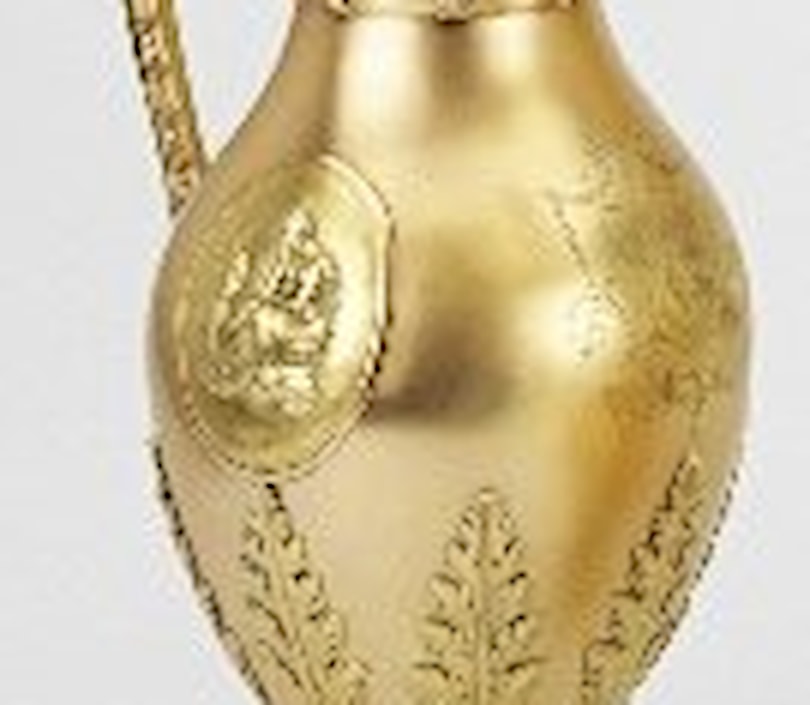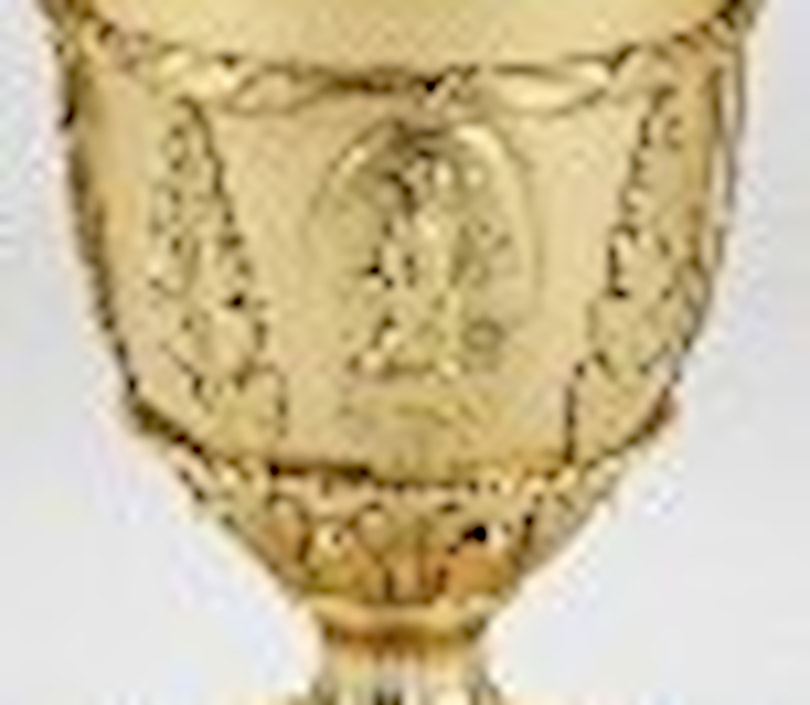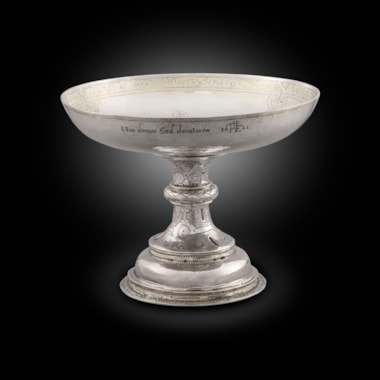The ewers with two-colour gilding, each on partly fluted circular foot with beaded borders and chased with scrolling foliage on a partly textured ground, the body with a lower border of acanthus and with oval medallions of muses and Cupids, the collar with ribbon-tied reeded border, with acanthus foliage under the lip, the hinged domed cover chased with scrolling foliage and applied with acanthus bud finial, the foliage-capped handle with husking, the front of each engraved with a coat-of-arms and motto, the cover engraved with a crest, marked on foot-rim and cover, the goblets with two-colour gilding, each vase-shaped on circular foot, similarly decorated with beaded, scolling foliate, acanthus, and ribbon-tied reeded borders, with two oval medallions depicting Cupids, each engraved with a crest, marked on foot-rim.
The arms are those of Fitz Maurice impaling O'Brien, for the Hon. Thomas FitzMaurice (1742-1794) of Llewenny Hall, Co. Denbigh, second son of John, 1st Earl of Shelburne, and his wife Mary, Countess of Orkney (1755-1831), whom he married on 21 December 1777
Thomas FitzMaurice (1742-1793) served as MP for Calne 1762-1774, also Co. Kerry, Ireland 1763-68, Chipping Wycombe, 1774-80, and High Sheriff of Co. Denbigh, 1781-82 and Co. Flint, 1782-83. He died in Hampstead, 28 October 1793.
The goldsmith Andrew Fogelberg, also identified as Anders Fogelberg, was born in Sweden in 1732 and apprenticed to a goldsmith in Halmsted in 1746. He is thought to have come to England from Sweden around 1770; he is recorded as a plateworker in Church Street, Soho in 1773. By 1780 he was in partnership with Stephen Gilbert, who had been apprenticed to Edward Wakelin in 1752. From their address at 29 Church Street, St Anne's, Soho, the output of this partnership was of exceptional quality and a restrained classical nature, highlighted by the use of small cameo medallions. This was also a characteristic of contemporary Swedish decoration as Charles Oman has pointed out ('Andrew Fogelberg, and the English influence on Swedish silver', Apollo, June 1947, pp.158-60) although medallions had been used there as decorative devices since the previous century.
The medallions in the present lot, as on most of their output, are probably after glass paste gems by James Tassie. Tassie, a modeller and reproducer of antique gems, supplied casts to Wedgwood and Bentley; N.M. Penzer notes (Paul Storr, 1954, pp.55-56) that he supplied most of the cameos and intaglios in Wedgwood's 1773 catalogue. Tassie's address, at Compton Street, second door from Greek Street, was for some five years just behind Fogelberg's workshop before his partnership with Gilbert (Tassie moved to Leicester Fields in 1778) and this proximity cannot fail to have influenced the decoration of Fogelberg's already neo-classical designs.
The designs of most of these cameos were also reproduced in paste by Wedgwood and Bentley who were supplied with casts by Flaxman and Hackwood as well as Tassie, indicating a common source, probably source books of ancient themes. The medallions on the present ewers and cups depict Calliope, the muse of Poetry, using a stylus to write on a large tablet, Euterpe, the muse of Lyric Poetry, holding two flutes, Cybele before a sacrificial altar, a draped female figure before a suit of Roman armour, and various depictions of Cupid: with Psyche, with a butterfly emblematic of Psyche, with wheat and a sickle, at a brazier, and with a bird and its nest.
Anonymous sale; Sotheby's London, 30 November 1972, lot 165
The Glory of the Goldsmith, Magnificent Gold and Silver from the Al-Tajir Collection, Christie's, London, 1989, p.145, no.107
Vanessa Brett, The Sotheby's Dictionary of Silver, London, 1986, no.1027
J. B. Hawkins, The Al Tajir Collection of Silver and Gold, London, 1983, vol.I, p.74-77
You May Also Like












































































